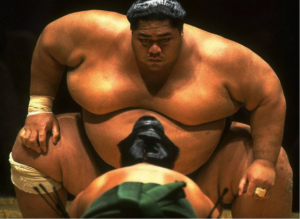Successful match-fixing is covert: no one boasts about it at the time. However, if there is sufficient data on actual results over time, possible patterns of match-fixing (as opposed to individual instances) can be identified by the use of probability theory.
One example where data were available led to an investigation by American economists Mark Duggan and Steven Levitt (American Economic Review 2002) into possible historical corruption in sumo wrestling. There are six sumo wrestling tournaments a year, each lasting 15 days with each wrestler participating once a day. Rankings which determine a wrestler’s social status and monthly income are revised after each tournament taking into account each wrestler’s win/loss record. Duggan and Levitt had information on tournaments from January 1989 to January 2000, covering 32,000 bouts involving 281 wrestlers and their examination revealed overwhelming evidence of match rigging in the final days of the tournaments. Each additional victory was worth about three ranking points except the eighth win which offered over 11 points. This non-linearity of rewards meant that in the crucial bout when a wrestler had seven wins he stood to gain much more than his opponent stood to lose, a situation which provided an opportunity for possible match fixing. An examination of the data showed that approximately 26.0% of all wrestlers finished with exactly eight victories and only 12.2% with seven, whereas the statistical expectation would have been for a frequency of 19.6% in both cases. Moreover on the last day of the tournament wrestlers with seven wins were victorious roughly 25% more often than would have been predicted.
Possibly this could have been due to putting in extra effort to ensure that vital victory but the evidence suggests otherwise. First, an examination of bouts featuring 29 wrestlers accused of corruption by insiders and those in which 14 wrestlers named by the same sources as clean showed remarkable differences in results. When two allegedly corrupt wrestlers met in a crucial bout the one who needed the win was 26 percentage points more likely to win than if they met in a non-crucial match. For two clean wrestlers there was no difference in the results whether one was on the margin or not. Second, in two periods (covering tournaments in May 1996, November 1999 and January 2000) when there was increased media scrutiny of the results because of allegations of corruption the percentages reverted to expected levels. Third, the loser in a ‘rigged’ match had an unusually high win percentage when those two wrestlers met the next time (the previous winner was 7% less likely to win this time than predicted): in effect matches were thrown in the expectation that a quid pro quo would ensue. Whether there was any additional monetary compensation for losing the crucial bout was beyond the parameters of the investigation, though it would seem from the nature of the irregularities that the corruption was organised by the training stables to which fighters belonged rather than the individual wrestlers.
Further research on the topic has supported Duggan and Levitt’s views. In this second investigation by Diett, Land and Werner (Journal of Sports Economics 2010) using 33,734 observations it was shown that between January 1995 and January 2000 the win record of wrestlers on the margin was 13% higher than expected and at the next meeting the previous winner was 10% less likely to win than predicted and that from May 2003 to November 2006 the respective figures were 9% and 13%. However between March 2000 and May 2003 abnormalities in winning probabilities virtually disappear. The one variable that changed during this period was a temporary lessening of the non-linearity of rewards by the Japan Sumo Association which removed the incentive to fix the result when one wrestler was on the margin of an eighth victory.
Whether these economists ever told a sumo wrestler (average weight 148 kilograms) face to face that he was cheating has not been documented!

Article © Wray Vamplew






